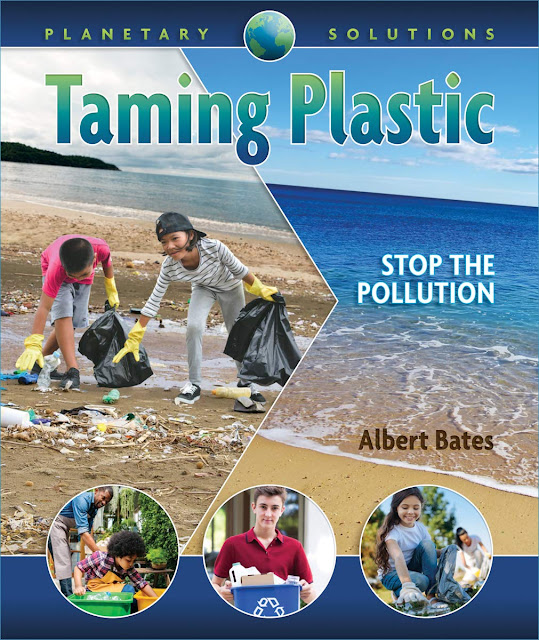Taming Plastic: Stop the Pollution by Albert Bates, 48 pp., RL 5
Planetary Solutions - Taming Plastic:
Stop the Pollution by Albert Bates
Review Copy from GroundSwell Books
(an imprint of Book Publishing Co., a community owned press dedicated to
publishing books the promote a healthy and sustainable lifestyle)
Back in January, I reviewed a handful of books for kids about plastic pollution and shared my own efforts to reduce single-use plastics in my life. I was surprised to find that the books I found most engaging and current were released by British publishers and not available in America - I had to order mine directly from the U.K. Then Taming Plastic: Stop the Pollution turned up on my doorstep. As I skimmed Taming Plastic: Stop the Pollution, I wanted to know who wrote this book and what his background was. Before I share the fascinating facts from the rabbit hole these questions took me down, my review of Bates's book for young readers.
Taming Plastic: Stop the Pollution is a solid, much needed reference book that covers all of the material in the previous books I have reviewed with a greater depth and complexity that is geared toward older (middle school) readers. The four chapters cover the invention of plastic, which also has an excellent breakdown of the different kinds of plastic and what they are most often used for, as well as a warning about overheating Teflon. Chapter two covers the issue of recycling plastic, why recycling plastic is coming to a halt and the possibility of plant-based plastics. Chapter three offers some inventive solutions for using plastic in the future - Bates's newest book for adults is Transforming Plastic: From Pollution to Evolution. Chapter four gives young readers inspiration and ideas on how to become an environmental activist while calling attention to companies and organizations that are making changes now and working to clean up plastic pollution, name checking Boyan Slat, founder of The Ocean Cleanup.
Taming Plastic, with stock photographs and traditional formatting looks and reads like a book created for educational purposes, which is what it is. However, after reading about Albert Bates, his colorful life and exciting experiences, I would love to see him create a book for kids on plastic pollution that reflects his personality and life experience. As an elementary school librarian and someone who has been reading, reviewing and selling (as a bookseller, for money, and as a librarian, for loan) books for kids for over two decades, this is the book we need now. With the omnipresence of the internet and all it brings, good and bad, along with the fact that children born in the last 5+ years are being raised with devices in their hands, the face of non-fiction books for kids needs to change if it is going to compete for their attention. Although they are intended for slightly younger audiences than Taming Plastic, Kids Fight Plastic and A Planet Full of Plastic and How You Can Help are superb examples of non-fiction books for kids that grab your attention and, thanks to the contemporary illustrations and formatting, keep you reading. I am grateful for a book like Bates's that will no doubt, be purchased for use in educational settings, but learning about and reducing/ending plastic pollution is something that is so urgent and immediate that I believe we need to make learning about it and inspiring young readers to think about it and care about it. Like Greta Thunberg, I believe it is the children who will need to school the adults on the dangers of our current thoughtless passion for plastic. And, being a book reviewer and librarian, I believe that books can be the spark that light a fire in young readers.
Rabbit Hole Fun: Albert Bates is a really interesting dude and I think he would be a great subject for a non-fiction picture book! First off, Bates has been a resident of The Farm since it was founded, almost fifty years ago. I first learned about The Farm, an intentional community of family and friends living on three square miles of land, in 2003 when I was pregnant and interested in trying natural childbirth (after the unnatural births of two children). I read Ina May's Guide to Childbirth, a title that was always in the pregnancy section (because it was a perennial seller) of the bookstore where I worked at the time. Gaskin, a midwife, and her husband, Stephen, founded The Farm, which included the Midwifery Center. While I had the help of a doula, I definitely believe that reading Gaskin's book, which educated me on many aspects of a woman's body and childbirth, despite having given birth twice before, was a huge factor in the natural birth of my son, one of the most empowering and incredible experiences in my life.
Albert Bates is a lawyer, author, educator and EMT and founding member of The Farm Ambulance Service. He argued environmental and civil rights cases before the U.S. Supreme Court and drafted legislature. While he lost his case seeking to shut down the entire nuclear fuel cycle in 1978, he raised troubling questions about the government's role in promoting nuclear power while suppressing public health affects. A master of permaculture, an environmental design system for creating sustainable human environments, Bates is also the Chief Permaculture Officer for a company focused on "commercial climate stabilization using off-the-shelf hardware and methodologies that let nature do what she does best."




